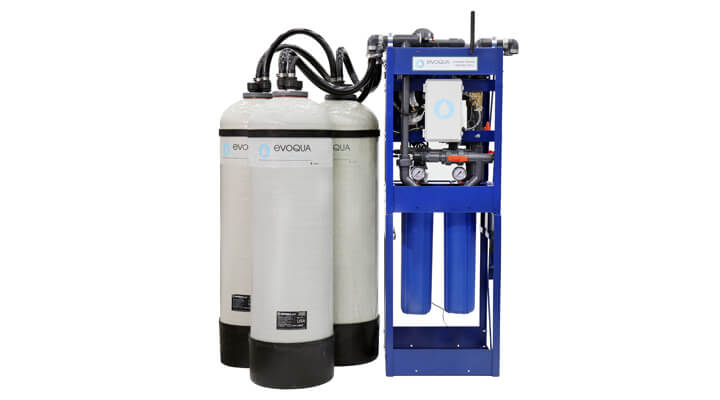Filter 0

Service Deionization (SDI) Systems
Water purification through service deionization

Water One® SD Test
Reliable water management solutions for simple deionization with remote monitoring. test
PLEASE VISIT EVOQUA.COM FOR OUR LIVE WEBSITE.
You can count on Evoqua for dependable, responsive service, with 65 customer support centers nationwide and 24/7 dispatch through a convenient service hotline. Our wide range of SDI solutions support flow rates from 0.75 to 250 GPM and resistivity from 50K to 18M Ohm. With Evoqua SDI, there's no capital expenditure on costly regeneration equipment and chemicals. We replace and regenerate your ion exchange resin tanks off-site whenever they become exhausted. With our proven technology and customer support, all you have to do for a dependable supply of high-purity deionized water is turn on the tap.
Extremely effective at removing minerals and salts for high purity DI water
Highly trained service reps deliver, install and maintain the equipment
No capital expenditure on costly regeneration equipment and chemicals

Water purification through service deionization

Reliable water management solutions for simple deionization with remote monitoring. test
Deionization (DI) is the removal of all ionized minerals and salts (both organic and inorganic) from a solution through the process of ion exchange. Because most non-particulate water impurities are dissolved salts, deionization produces a high purity water that is generally similar to distilled water. Compared to distillation, deionization is faster, less energy-intensive, and more cost-effective. In addition, it is an on-demand process that supplies highly purified water as needed — an important feature because water at extreme levels of purity degrades quickly.
Deionization filters operate by exchanging positive hydrogen and negative hydroxyl molecules for the positive and negative contaminant molecules in the water. Positive chemicals like sodium, calcium, iron, and copper change places with the hydrogen molecules, and negative chemicals like iodine, chloride and sulfate change places with the hydroxyl molecules. This process is typically done by two ionized resin beds that are opposite in charges: cationic (negative) resin and anionic (positive) resin. Positively charged ions are removed from the solution by the cation resin in exchange for a chemically equivalent amount of hydrogen ions. Negatively charged ions are removed by the anion resin in exchange for a chemically equivalent amount of hydroxide ions. The hydrogen and hydroxide ions introduced in this process unite to form pure water molecules.
With Service Deionization (SDI), Evoqua regenerates ion exchange resin as a service at one of our conveniently-located North American resin regeneration plants, saving customers the cost of investing in on-site equipment .
Deionized (Dl) water is an essential ingredient in hundreds of applications, including medical, laboratory processes, pharmaceuticals, cosmetics, electronics manufacturing, food processing, plating, countless industrial processes, and even the spot-free rinse water at the local car wash. Typically, it serves as an ultra-pure ingredient, a "perfect" cleaning solvent, or as the foundation of a process water recovery/reuse strategy.
Cationic resin is typically made from styrene containing negatively charged sulfonic acid groups, pre-charged with hydrogen ions. This resin attracts the positively charged ions in the water (Ca++, Mg++, Na+, etc.) and releases an equivalent amount of hydrogen (H+) ions.
Anionic resin is also made from styrene and contains positively charged quaternary ammonium groups. It is pre-charged with hydroxide ions. This resin attracts negatively charged ions (HCO3-, Cl-, SO4--, etc.) and releases an equivalent amount of hydroxide (OH-). The hydrogen and hydroxide ions then combine to form water. (H+ + OH- = HOH or H2O.)
The two resins can be ionized at weak or strong levels. Weaker ionization exchanges only the weak ions, providing for greater capacity and longer filter life; while stronger ionization provides a higher degree of ion exchange at the cost of reduced capacity and shorter filter life.
Over time, positive and negative contaminants in the water displace all the active hydrogen and hydroxyl molecules on the ion exchange resin and the filter loses its ability to remove contaminants. The lifecycle of a DI filter can vary greatly with the quality of the feed water, the type of resins used, and the filtration system configuration.
When resin is exhausted, it must be removed from the filtration system and regenerated. Equipment and chemicals for regeneration can represent a significant capital investment, in addition to your investment in the filtration system itself. Service DI from Evoqua provides regeneration off-site as a service, eliminating the need for this capital expense.
In addition to ion exchange resin technology, DI can be done through a technology that uses electricity, ion exchange membranes, and resin. In electrodeionization (EDI), electric current is used to continuously regenerate the ion exchange resin, reducing the consumption of fuel and chemicals used in the regeneration process. Evoqua's IonRight® systems combine reverse osmosis (RO) with EDI to provide continuous, consistent, high-purity water in a compact, plug-and-play package.
No. While it is extremely effective at removing minerals and salts, deionization does not remove dissolved organic chemicals, viruses, bacteria and particulates. For that reason, DI systems are typically configured with carbon filtration, ultraviolet (UV) purification, and reverse osmosis (RO) to remove these additional contaminants.
Technical standards on water quality have been established by a number of professional organizations, including the American Chemical Society (ACS), ASTM International, the U.S. National Committee for Clinical Laboratory Standards (NCCLS), which is now CLSI, and the U.S. Pharmacopeia (USP). These standards apply to DI water as well as to water purified through other processes. The ASTM, NCCLS and ISO 3696 classify purified water into Grade 1-3 or Types I-IV depending upon the level of purity. These organizations have similar, although not identical, parameters for highly purified water. Many laboratory, pharmaceutical, medical, research and dialysis applications require ultra-pure water to meet one of these standards.